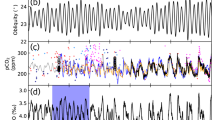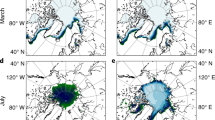Abstract
WILSON'S theory1 that Pleistocene glaciations might be initiated by massive surges of the East Antarctic ice sheet has been supported on climatological grounds by Flohn2, and Hollin3 outlines several geological tests of the idea. If a surge occurred, sea level would rise rapidly by many metres and, according to Hollin and Flohn, the oceans would cool significantly—especially the Atlantic. The sea-level rise would quickly be followed by falling sea level as northern continental ice sheets developed. Numerical values approximately would be (1) sea-level rise of 10–20 m over a surge period of several hundred years3; (2) global cooling of about 1° by virtue of the albedo of the greatly increased floating ice-field in sub-Antarctic waters produced by the surge2, and (3) the high sea level should persist for no more than a few hundred years as northern continental glaciation is envisaged as starting to form when the peak is reached, if not before, and this ice volume is likely to equal many metres of sea-level equivalent after 1,000yr(refs 2,3). An alternative surge hypothesis for glacial initiation by Mercer4 invokes rapid disintegration of the West Antarctic ice sheet—believed to be inherently unstable because its base is extensively below sea level5. Rapid disintegration would cause a sea-level rise of about 5 m, perhaps as rapid but smaller in magnitude than Wilson's East Antarctic surge, followed about 1,000 yr later by mild warming (0.5–1 °C) of equatorial Atlantic temperatures as production ceased of Weddell Sea bottom water6. The time lag between West Antarctic ice disintegration and northern glacial initiation is uncertain under this hypothesis, but may be a few thousand years if circulation changes of the deep Atlantic ocean are involved. Evidence presented here of sea-level changes and temperature variation argues against the Wilson hypothesis but does not preclude all ‘surge’ mechanisms.
This is a preview of subscription content, access via your institution
Access options
Subscribe to this journal
Receive 51 print issues and online access
$199.00 per year
only $3.90 per issue
Buy this article
- Purchase on Springer Link
- Instant access to full article PDF
Prices may be subject to local taxes which are calculated during checkout
Similar content being viewed by others
References
Wilson, A. T. Nature 201, 147–149 (1964).
Flohn, H. J. Quat. Res. 4, 385–397 (1974).
Hollin, J. T. Boreas 6, 33–51 (1977).
Mercer, J. H. Int. Ass. Sci. Hyprol, Publ. 79, 217–225 (1968).
Weertman, J. J. Glaciol. 13, 3–12 (1974).
Hughes, T. Rev. geophys. Space Phys. 13, 502–526 (1975).
Steinen, R. P., Harrison, R. S. & Matthews, R. L. Bull. geol. Soc. Am. 84, 63–70 (1973).
Chappell, J. Bull. geol. Soc. Am. 85, 553–570 (1974).
Bloom, A. L., Broecker, W. S., Chappell, J., Matthews, R. L. & Mesolella, K. M. Quat. Res. 4, 185–205 (1974).
Chappell, J. & Veeh, H. M. Bull. Geol. Soc. Am. 89, (1978).
Ku., R. L., Kimmel, M. A., Easton, W. H. & O'Neil, T. Science 185, 959 (1974).
Shackleton, N. J. & Matthews, R. L. Nature 268, 618–620 (1977).
Chappell, J. & Polach, H. A. Bull. geol. Soc. Am. 87, 235–238 (1976).
Marshall, J. F. & Thom, B. G. Nature 263, 120 (1976).
Thom, B. G. (eds Davies, J. L. & Williams, M. A. J.), Time, Space, and Landforms in Australia (Australian National University Press, Canberra, 1978).
Kennett, J. P. & Huddlestun, P. J. Quat. Res. 2, 38–44 (1972).
Author information
Authors and Affiliations
Rights and permissions
About this article
Cite this article
CHAPPELL, J., THOM, B. Termination of last interglacial episode and the Wilson Antarctic surge hypothesis. Nature 272, 809–810 (1978). https://doi.org/10.1038/272809a0
Received:
Accepted:
Published:
Issue Date:
DOI: https://doi.org/10.1038/272809a0
This article is cited by
-
Climate and paleoclimate: What we can learn about solar luminosity variations
Solar Physics (1981)
-
Stable isotope and sea-level data from New Guinea supports Antarctic ice-surge theory of ice ages
Nature (1980)
-
Coral morphology, diversity and reef growth
Nature (1980)
-
Climate and sea level in isotope stage 5: an East Antarctic ice surge at ∼95,000 BP?
Nature (1980)
-
Spectrum of climatic variations and their causal mechanisms
Geophysical Surveys (1979)
Comments
By submitting a comment you agree to abide by our Terms and Community Guidelines. If you find something abusive or that does not comply with our terms or guidelines please flag it as inappropriate.



